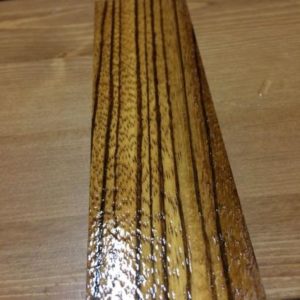I’m in the midst of making a Zebrawood table and having issues finishing the board. I’ve tested various stain and oil combos on various spare pieces. I can’t seem to be able to get rid/hid the smaller pores. Are there ways to get rid or hide these smaller pores? As I’m looking at many pictures and examples of zebrawood finishes and I don’t see those little pores. Photo included you’ll see the little pores have turned black.
I’ve tried wood filler, sanding combo
Stains/poly
Best result so far – just many coats of tung oil
















Replies
There are certainly pore fillers that will do this task. Sherwin Williams makes a good one, but only in the gallon size. The one most easily found is likely to be Behlen Por-O-Pak. There are even some transparent pore fillers, such as one by Crystalac that could work, though may take several applications since it shrinks quite a bit as it dries. Be sure to follow directions on these pore fillers, though in general I would alway allow more time than recommended before overcoating with a topcoat.
Ichiro,
I second what SteveSchoene suggests. Using Pore filler per the manufacturer's instructions (generally to flood it on and work it into the wood, then wipe off all remaining on the surface with a coarse rag after the filler/solvent mixture has partially dried to a "leathery" appearance) will fill any open-pored wood to a perfectly smooth appearance, ready to be finished. Under a film of finish, there will be no dimpling of the final surface and such woods can be very beautiful finished this way.
But, I recommend embracing the open-pore look of such wood. It's part of the beauty of the species which are often finished in a way to enhance that beauty. Your finish looks bad because it is thick and has piled up around the edges of the pores and grain.
Your tung oil method will work if applied in very thin coats and wiped completely off the surface after allowing to penetrate for a while. Make sure to get all the residual off and give it a day or more to cure before the next application.
I use lacquer or shellac in very thin applications to mimic an oiled surface appearance. Both lacquer and shellac are a much more permanent, protective finish than oil finishes.
I've attached images of Zebrawood and Santos Rosewood. Santos has finer pores than Zebrawood but both are open-pored woods.
Rich
We all like different things about the wood we work with. My wife loves zebrawood so I spend considerable time with it. I have to agree with her on one thing, the pores add character.
But, one thing I've had some success with is filling the pores only with a glue syringe and water-based urethane. It's time-consuming, especially waiting for the urethane to dry but it doesn't discolor the wood.
It'll bulge a little, like an asphalt patch on a road, but that's easily remedied.
Hope this helps.
This forum post is now archived. Commenting has been disabled